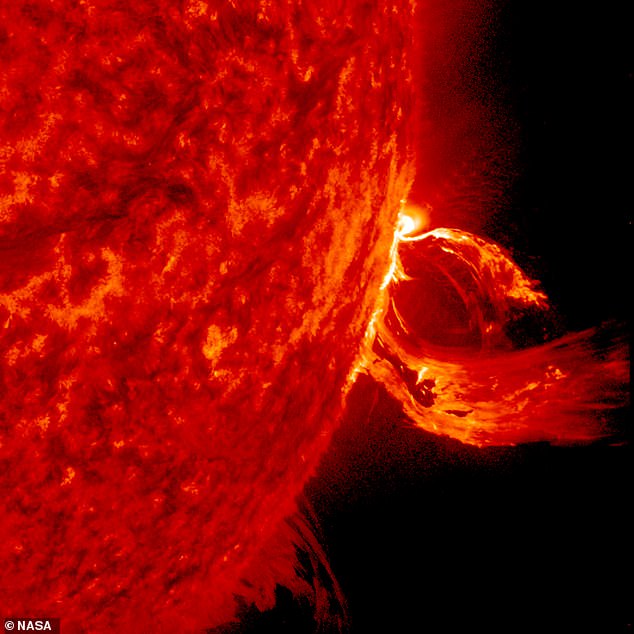
A powerful solar storm is due to hit Earth today and could cause havoc for power grids, weather agencies have warned.
The UK’s Met Office and the US’s National Oceanic and Atmospheric Administration (NOAA) have forecasted a coronal mass ejection (CME) – a massive expulsion of plasma from the Sun’s corona (its outermost layer) at around 12pm EST (5pm BST) today.
Possible effects of the solar storm, caused by the CME, are power grid fluctuations and orientation irregularities for spacecraft in the form of ‘increased drag’ on low-Earth orbiters.
The aurora – a natural light display in Earth’s sky, also known as the Northern Lights – may also be visible as low as New York in the US and the north of England in the UK.
The storm comes as the National Grid warned the gap between energy supply and demand this year is likely to be at its lowest level for six years. The organisation said it was confident blackouts can be avoided, but warned it was possible if ‘we have a very cold winter’.
A solar or geomagnetic storm is a major disturbance of Earth’s magnetosphere – the area around Earth controlled by the planet’s magnetic field – often caused by CMEs. Pictured, a coronal mass ejection (CME) from the sun, as captured by NASA’s Solar Dynamics Observatory satellite on June 17, 2015

Today’s solar storm, or geomagnetic storm, is rated ‘G2’ (on a scale of one to five), so it’s considered to be ‘moderate’, according to the National Oceanic and Atmospheric Administration (NOAA)
A solar or geomagnetic storm is a major disturbance of Earth’s magnetosphere – the area around Earth controlled by the planet’s magnetic field – caused by CMEs.
Today’s solar storm is forecasted at around 12pm ET, or about 5pm BST.
‘Event analysis and model output suggest CME arrival around midday on 11 Oct, with lingering effects persisting into 12 Oct,’ NOAA says on its website.
Today’s solar storm is rated ‘G2’ (on a scale of one to five), so it’s considered to be a ‘moderate’ storm.
In the UK, the Met Office puts the event anything between G1 and G3, and anywhere between the hours of 10am on Monday and 10am on Tuesday.
The CME will likely cause ‘minor to moderate geomagnetic storms’, the Met Office says, resulting in ‘enhanced auroral activity’.
‘Minor storms may continue into 12 October, before a fast wind from a coronal hole may arrive, perhaps continuing the rather active period of geomagnetic activity.
‘Aurora is possible through 11th across much of Scotland, although cloud amounts are increasing, meaning sightings are unlikely.
‘There is a slight chance of aurora reaching the far north of England and Northern Ireland tonight, but cloud breaks and therefore sightings are more likely in Northern Ireland.’
In the Southern Hemisphere, the Aurora is more likely to be seen at high latitudes – locations nearer the South Pole – although there’s a slight chance of aurora reaching the mid latitudes.
This article originally appeared on Daily Mail



More Stories
Today’s News: March 26, 2024
The Greatest Purveyor of Violence In The World
Video: Fred Dashevsky – The CPI Fallacy